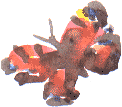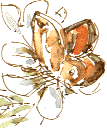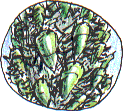 |
Ants and AphidsFriday, 20th July 2001, West Yorkshire |
![]()
![]()
![]()
![]()
![]()
![]() This Month
Rocks
History
Workshop
Links
Home Page
This Month
Rocks
History
Workshop
Links
Home Page
![]()
 ON A 50 YARD stretch of the towpath three Gatekeepers are making short display flights. Each patrols its (as these are males I should say 'his') short stretch of wayside bracken, bramble and ragwort. They look fresh and undamaged so they have probably recently emerged - and the same goes for the Red Admiral and the Small Tortoiseshell that are flying nearby.
ON A 50 YARD stretch of the towpath three Gatekeepers are making short display flights. Each patrols its (as these are males I should say 'his') short stretch of wayside bracken, bramble and ragwort. They look fresh and undamaged so they have probably recently emerged - and the same goes for the Red Admiral and the Small Tortoiseshell that are flying nearby.
 The heads of Tansy are still buttoned up in tight bud. On the stem just below the flowerheads there's a green collar of aphids standing shoulder to shoulder, all facing head downwards. My eyes won't focus so closely these days, so I look through one of the objective lenses of my binoculars and move the eyepiece in close towards the aphids. The wide-angle view takes in scores of them. This species is leaf green with black legs. On another stem a few red-brown ants are climbing amongst the
The heads of Tansy are still buttoned up in tight bud. On the stem just below the flowerheads there's a green collar of aphids standing shoulder to shoulder, all facing head downwards. My eyes won't focus so closely these days, so I look through one of the objective lenses of my binoculars and move the eyepiece in close towards the aphids. The wide-angle view takes in scores of them. This species is leaf green with black legs. On another stem a few red-brown ants are climbing amongst the Parthogenesis
Another remarkable aspect of aphids at this time of year is that almost all the young are born through the process of parthogenesis, virgin birth. There's no caterpillar stage during the growth of the aphid, so in this colony there is a variety of sizes from the size of a very large grain of sugar almost up to the size of a small rice grain. A winged generation will appear when the population outgrows its food supply and needs to move on. According to The Penguin Dictionary of Natural History, the winged and unwinged generations of females alternate throughout the summer.The males won't appear until the end of the summer. They'll then mate with the females in the normal way and the eggs that are laid will hatch out the following spring.
![]()
Richard Bell,
wildlife illustrator
E-mail; 'richard@willowisland.co.uk'
![]() Next page
Previous page
This day last year
This month
Nature Diary
Home Page
Next page
Previous page
This day last year
This month
Nature Diary
Home Page
![]()